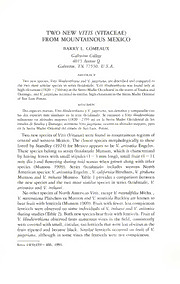
TWO NEW VITIS (VITACEAE) FROM MOUNTAINOUS MEXICO PDF
Preview TWO NEW VITIS (VITACEAE) FROM MOUNTAINOUS MEXICO
, TWO NEW VITIS (VITACEAE) FROM MOUNTAINOUS MEXICO BARRY COMEAUX L. Galveston College 4015 AvenueQ Galveston, TX 77350, U.S.A. ABSTRACT Twonewspecies,VilahlooclunrthicaiaandV''.jaegeruina,aredescribedandcomparedro rhetwomostsimdarspeciesinseriesOcachntcilei. Vitishloodworthtanawasfoundonlyat highelevations(1820—2360m)intheSierraMadrcOccidentalinthestatesofSinaloaand Durango,andV.jaegerianaoccurredinsimilar,highelevationsintheSierraMadreOriental ofSanLuisPotosi. ri-sumi-:n Dosespecicsnuevas,Vili.shlooduorthuinuy\'.jatgeriana,sondescritasycomparadascon lasdosespecics massimilaresen laserieOaukntales. Seencontroa ViSisbloodworthiana solamenteen altitudes mayores(1820—23')9m)en laSierraMadreOccidentaldelos estadosdeSinaloayDurango;asimisrnoVitnjaegeriana,ocurrioenaltitudesmayores,pero enlaSierraMadreOrientaldelestadodeSanLuis, Potosi. TwonewspeciesofVitis{Vitaceae)werefoundinmountainousregionsof centralandwesternMexico. Theclosestspeciesmorphologicallytothese listed by Standley(1924) forMexicoappears to be V. arizonica Engelm. ThesespeciesbelongtoseriesOccidentalesMunson, whichischaracterized byhavingleaveswithsmallstipules(1—3mmlong), smallfruit(4—11 mmdia.)andfloweringduringmidseasonwhengrownalongwithother species (Munson 1909). Series Occidentales includes western North Americanspecies:V,arizonicaEngelm., V.caiijornicaBentham,V.girdiana Mtmson and V. treleaseiMunson. Table 1 providesacomparisonbetween the newspeciesandthetwomostsimilarspeciesinseriesOccidentales, V. arizonicaand V. treleasei. NootherspeciesofNorthAmericanVitis,exceptV.rotundifoliaMichx. V. mnnsonianaPlanchonexMunsonandV. monticolaBuckleyarcknownto bearfruitwithlenticels(Munson 1909).Fruitwithfewer,lessconspicuous lenticelswereobservedonsomeindividualsofV. treleaseiandV. arizonica duringstudies(Table2).Bothnewspeciesbearfruitwithlenticels.Fruitof V^ bloodworthianaobservedfrom numerousvines inrhefield, consistently werecoveredwithsmall,circular,tanlenticelsthatwerelessobviousasthe fruit ripenedand became black. Similarlenticelsoccurred on fruit ofV. jaegeriana, although in somevines the lenticels were notconspicuous. SiDA l4(3):459-466. 1991. 460 NHW TAXA Vriis Hi.ooowoRTHiANA Comcaux, sp. nov. Fig. 1. (faillesan^t^ularcsccnsteres,glabrcscfnttsadintcriLliimpuhtruli,striari,sineIcnticcllis; apicesct folia immariiramanitcstecoloracacumpigmc-ntum rubrum. Folia picrumtjiic intcrdumsinelobaca,longa-cordiformaadferedcltoidea,longa-acumminata,cordataad lere truncata lobi laterales intcrdum divergentes acutati ad acuminari; lamina marura glabratalimitataadvenaeprimariaseraxillares.Bacxaenigrae,glaucae,6—11mmdiam.; tactaecum lenticelliscirculatesfulvae;semina v5^^mmlonga, 3^3.') mmlara. Vinesto^lOm,stemsoncurrentseasongrowrhglabrescentoroccasional- lypubescentthenturningglabrescent,striatecl;branchletsangled,becom- ing terete; internodes 3— 16 cm long; nodes rarely encircled with red pigmentation;pithinterruptedatnodesbyadiaphragm2—3mmthick; bark brown, shredding during second season growth; lenticcls absent; growingtipsglabroustoglabrescent, occasionallypubescent,withwhite totantrichomes, notenvelopedbyyoungleaves,ordinanlytipsandhnnia- iNW leavesprominently coloredwith redpigmentation\ bud scales glabrous to pubescent, 3~4 mm long, brown. Leaves Umg-cordijorm to nearly lon^- deltoid. Hat, usually3-lobed,withlaterallobesacutetoacummate, often divergent, apex long aanminate, base cordate to nearly truncate, lateral sinuses acute (rcxmded on ground shoots); margins serrate to nearly crenate,withteeth0.5~3mmlong,orientedperpendicularlytomargin, towards apex or base, triangularor with concave orconvex sides, occa- sionally ciliate, with veins extendmg beyond teeth, midrib with 4—7, usually6j:)airsofprominentveins;laminaglabrousonbothsurfacesojmature leaves, except for simple, straight, pointed trichomes and arachnose trichomes on primary veins and vem axils, 7—13 cm wide, 9—17 cm long; petiolesglabrous topuberulenr, striated, 3^10cm long;stipules brown, glabrous to pubescent, 1—1.5 mm wide, 1—2.5 mm long, caducous;pubescencewhitetotan,consistingofstraight,pointed,simple trichomes and arachnose trichomes. Tendrils and inflorescences absent every third node, tendrils bifurcate or tnfurcate, to 20 cm long. Inflorescences 1—8 cm long, peduncles 1.2—4.5 cm long, shoulder s1ma—l4l,.5tacn.mclirocnugl.arFlleontwiecerlss,n0o.t6ob—se1r.v1edc.mFirnuidtiaamebetrerry;,sbklianckt,hignl;apuucloupsclweiatr,h greenishtopurplish.Seedsbrown,irregularinshape,ovatetonearlypyri- form, 3-3-5 mmwide, 3.5—5 mm long. Typf.:MEXICO.Duranco:16.^kmWofDelDiabloand^'^.^kmliofTropicofCancer viaHwy40,2,300m, IJul 1986,Comeaux4219(hoi.otvfi;:SMU;iscriYPRs:MEXU, FH). HwPyar4a0t,yp2,ls1.74Dmu,ra1nJoulo:193H96.kCmomWeauoxf4De2l14Di(aSbMlUo);an_d^7.143kkmmWEooffTDreolpiDciaolf^lCoaancnedr,14v.i6a 46 FIG. I.TypespecimenofVtlishlmulwdrthtana(Cimeaiix42!9). 462 aaCWHk1onn,mnwddi9yio9i'04f;0c,24io2DH01fmXe,,Tkl14rm2o2(,D1p1SiWiJ1M6auco1Ubl3fo(l)TfoS;m1rMC,9aaoU58nn2)6p1dc.,;iJe0curC12lo8ko2vf.m.mi16Cea69aa8WHkku6nwmx,mcyoe4CEfWr2o4vDm10oef,ie2olaaTf2j(Hr,DDLSowi1expMay4li4Ub3c2)4lD1;0omoiH,,fa4ab(Cn91l1Sad.,oJMn68uUc52al)ek00nr.md1mm9v,S82iWi69aJWn,u.aHl4olCfowoo1kfa,yDm:mTem1rl459ouE028pDx,.6iio43,cfa22bk,CCT1l2oarmoo3mn5pc6eaW(ieanScrmudM,xooUvf2fi4).aD12;C4e0aJHl93unkw3,lcDm.eyi44r1aE294bkv1H0liom0,6oaf TropicofCancerviaHwy40, 2,150m, 1Jul 1986,Comea/^x4213(GA,SMU). TahiI 1.ComparisonoffourspeciesofseriesOccnienlalesMunson. (Character \(hloiidivitrthiana V.jaegeriana V,eirizoniai V.Irekaset (11VinesSampledX11VinesSampIed)(I2VinesSampledK15VinesSampled) 1.Leaveslohed usually *rarely usually usually 2 Leavespubescent abaxialsurface gt^pr\pb' gs,gt,pr,pb gs adaxialsurface gs gs,gt gs,pr,pb gs 3.Leafindex (wuith/Length) mean 0.7 0.7 0.9 0.9 range 0.5-0.9 0.6-0.9 0.8-1.1 0.7-1.1 4.Teethnumber (for1side ofleaf) mean 27 20 21 30 range 20-41 15-27 14-26 13-30 y Midrib|iairs [lerleaf mean 5.4 4.3 4.0 4.0 range 4-7 4-5 3-5 3-5 6, liasalsinuswidth (indegrees) mean 107 77 73 79 range 70-170 30-150 **-30-175 -1-150 7.Stemspubescent «^'gt,pr,[-b pr,pb pr,pb gs,gt,pr 8.Stemtipsptilx-scent g.s,gt,pr pb gt,pr,pb gt,pr,pb y.Sptuebmesctiepncecolor («)',(w)'",re',t" (w),t,ru' w,(re) w,g,re 10.Stemtipenvelopes1 byleaves n'",f^' n,f f,sl'^ n.LsLst'' 11.Lpeuabfesacnedncsetecmolor w,t w,t,ru w w 4231----ggpptsrb ===== ggpprllauuraabbebbeelrrrsyeoucsuleocsebnenstntetrved 8967)•--------gwrtreu ==^== gwrtreuarhdfneieetsnecent 11112301-------sSfnit ==== ssfnlateiirgngoathntltgiyllvyye *C)nlytwoleaveswereobservedfromdifferentvinesoutofmanyindividualsexaminedinthef'lekl **Negativevaltiesrelatetocaseswhereleafbasesoverlapped. . 463 Tabli;2.SpecimensofVilaarizonicaandV./releaserexaminedincomparisonwithhluoclworthianaand jaegeriana VcnsARIZONICAlingelm.ARIZONA.CochiseCo.:9.6kmSofSierraVistaonCarrCanyonRd., 1,500m,5Jul1986,Comea!ix4236,4237.423H.42.59,4240and424/(SMU).SantaCruzCo.:28 kmSofSonoitaviaHwy83,1,500m,5Jul1986,Cow^^z/.v4242(SMU);28.5kmSofSonoitaviaHwy 8m.,3,51J,u5l8019m8,6,5CJoumlea1i9i86x,42C4o5me(aSiMrUx)4;24h}kamndW42of4!4;,(cSiMryU)l;imi1t.s0iknmNoNgla;leosfNvioagaHlwesyv8i2a,H1w,y17582m,,15,2J0u0l 198V6i,TiCsoTmReHaiu.ExAS4E2i46M.un4s2o4n7.aAnRdI4Z2O4HNA(SMMUa)r.icopaCo:FishCreekHillbridgeviaHwy85,NWof LNoEstWDuMtEcXhImCaOn.StC.atParrokn,C7o0.:04m,km6NJuElo1f9A86r,agOomnnvaiiaixHw4y2491.2,422,5100.04m2,514.Ju4l2512986a,ndCo4m2e5a3ux(S4M2U2)6.. 4227and4228(SMU);3kmNEofAragonviaHwy12,2,075m,4Jul1986,Comeaux4229(SMU). SocorroCo.:1.5kmdownstreamfromWaterCanyonCampgroundbetweenstreamandroad,Cibola NationalForest,2,180m,4Jul 1986,Comeaux4220.4221.4222.4223.4224and4225(SMU). ThisspeciesisnamedinhonorofRJ. Bloodworth(1950-),grapebree- derandfellowstudentunderthedirectionofthelateW.B.Nesbitt.Jeffis acknowledged for his assistance in the author's research, willingness to share his great knowledge, and for his devotion to the vine. Also, the epithetbloodworthianaseemsappropriateasthedark-redgrowingtipsand young leaves thatcharacterize thisspeciesaredistinctive intheseries. V/V/i bloodworthiana was found only at highelevations(1,820—2,359 m) in pine forests within the Sierra dc las Ventanas mountains, Sierra MadreOccidental,inDurangoandSinaloa.Annualrecipitationis40—80 cm and minimum temperatures range from -10° to 0°C(Rzedowski & Huerta 1978). This species occurs in dry or relatively moist, but well- drainedsites,withoutsympatricspecieso^Vitis.Morefieldstudiesarenee- ded toascertaintheoveralldistributionofV. bloodworthiana. The long-cordiform leaves, as indicated by thesmall leafindexvalues (Table I)forV. bloodworthianaand V. jaegeriana,easilyseparatethesefrom the two similar species in series Occidmtales. Vitis bloodworthiana differs fromV.jaegerianainhavingmoreteethandpairsoflateralveinsperleaf, consistentlybroaderbasalsinuses,andthedarkred-coloredpigmentation ingrowingtipsandyoungleaves. Allofthenearly70seedlingsgrownin containersoutdoorsatGalvestonCollegefromonecollectionofV. blood- li'orthiana {Comeaux4213) easily were differentiated within two months aftergermination from seedlings ofnumerousotherspecies ofVitis, in- cludingV. treleaseiandV.arizonica, bytheirbrilliantredgrowingtipsand long-cordiform leaves. Four seedlings grown for one season, each with stemsover2 minlength, weredistinguishedreadilyfromabout300in- dividualsofsimilarsize, representing numerousspeciesand hybrids, by theirredgrowingtipsandvariousdegreesofredpigmentationinallma- ture leaves. 464 ViTisjAFXiERiANA Comcaux, sp. nov. Fig. 2. Caulcsant,aiiatcscen.steres,pubcruliobscuraadconspica,striati,sineIcnticcllis.Folia sineiobaripierumque,lon^a-cordiforma,long-accuminara,cordata,laminamaturasupra glabrasadglabrescentes,infrapuberulilevitcradmodice,alinquandoglabresccntc,tricho- matatulvaandterruginea,velalba.Baccaenigrac,glaucae,6-11mmdiam.,tectaecum lenticelliscircularcstulvae;semina35—5mmlonga, ^~5mmlata. Vinesto7 m,stemsoncurrentseasongrowthpuberulanttopubescent; striated; branchletsangled becoming terete; internodes .^—10 cm long; nodesfaintlytoconspicuouslyencircled with redpigmentation, pith in- terruptedatnodesbyadiaphragm2—3mmthick;barkbrown,shredding duringsecondseasongrowth,lenticelsabsent;growingtipspubescent,tan orrufescent,occasionallywhite,notenvelopedbyyoungleaves;budscales pubescent, 2—3 mmlong, brown. Leaveslong-cordiform, flat, rarelylohed, then lobes acute, apexUmg-acmmnate, base cordate, lateral sinuses acute (when present); margm serrate, with teeth 0.5—3 mm long, oriented perpendiculartomargin, towardsapexorbase, triangularorwithconvex sides,ciliate,withorwithoutveinsextendingbeyondteeth,midribwith4 to7pairsofprominentveins;laminawithglabroustoglabrescentadaxial surfacesonmatureleaves, abaxialsurfacespubescenttopuberulent,occa- sionallyglabrescentonmatureleaves,notglaucous,withorwithouttufts oftrichomes in axils ofmajor veins, 4—10 cm wide, 6—15 cm long, petioles pubescent to puberulent, faintly striated, 1.3—7.5 cm long; stipules brown, pubescent to puberulent, 1—1.5 mm wide, 1—3 mm long, caducous; pubescence tawny, rufescent or white, consisting of straight, pointed, simpletrichomesorarachnosetrichomes. Tendrilsand mflorescences absent every third node, bifurcate, to 20 cm long. In- florescences 1.2—5.8 cm long, peduncles0.6—4.7 cm long, shoulders 0.2—2.3 cm long, occasionally replaced by a tendril. Flowers not observed. Fruitaberry, black, glaucous, withsmall, tan. circularlenticels, 0.6— 1.1 cmindiameter;skinthinpulpcleartopurplish. Seedsbrown, irregular in shape, ovate to nearly pyriform 3—5 mm wide, 4-5 mm long. Typi;:MEXICO.SanLuisFotosi:86.7kmWofjet.Hwy70and69inRioVcrdc, 2,1F5a0ram,rvp2i:4s:ASuagnL1u9i8s7,PoCioomseia:i/9x4.466HkIm(Wnoi.oofrjvepti;H:wySM7U0;anid.so6t9ypei;ns:RiMoEVXerUd,e,P2H,)4.00m, 27Jun 1986,Comeaux4176. 4177and4I7S(SMU);75.7km I.e., 1,9.38m, 28Jun 1986,Cumea/LX4206(SMU);92.6km I.e., 1,815m,24Aug 1987,Comeaux4674-7 (SMU);86.7km I.e., 2,150m, 24Aug 1987,Comeaux4679,4680(SMU). This species is named for the grape breeder, Hermann Jaeger (1844- 1895>), Neosho, Missouri (Smith 1962). Thomas V. Munson (1843—1913), the world renowned grape breeder, referred toJaeger as 465 FIG.2.TypespecimenotVitisjaegeriana(Coinmiix4(yHI] . 466 "myesteemed co-worker" who"formorethantwentyyearshunt[ed}and hybridizeCd] grapes" (Munson 1900). A grateful French government awardedJaeger the Cross ofthe Legion ofHonor m 1889 for his con- tributionstowardssavingtheFrenchwineindustry, previouslydevastated bythephylloxerarootlouse(Smith 1962).Hermannandhisbrother,John Jaegar sent millions ofgrape cuttings to France as phylloxera resistant rootstocksforthe native French varieties. Vitisjaegeriatuiwasfoundonlyathighelevations(1815—2400m)inthe SierradeJuarezmountains,SierraMadreOriental,inSanLuisPotosi.Veg- etation at the collection sites is dominated hyJ/miperus spp. Minimum temperatureand annual precipitationaresimilartothosereported for V. hloodu'orthiana(Rzedowsik,J. andL. Huerta 1978). Vitisjaegerianaoccu- piesrelativelydriersitesthantheformerspecies,andalsohasnoassociated sympatric species ofVitis. Additional field work is needed toclarify the distribution of W.jaegeriana Leaves of V. jaegeriana examined during field work consistently were withoutanylobing,exceptforafewisolatedleavesobservedonlyontwo vines. This charactereasily separates iffrom V. hloodworthiana, the only speciesinseriesOccitkntakssimilarlong-cordiformleaves.Anotherdistinc- tivefeatureofV.jaegerianaisthegenerallytanpubescenceongrowingtips, and young stemsand leaves. ACKNOWl.lUXiI'MIiNIS TheauthorisgratefulfortheassistanceofC.O. Focrster,JrandDr. W. L. HagcrmanduringfieldstudiesinAugust 1987,andalsofortheassist- anceofDr R R. Fantz in thepreparationofthis manuscript. Ri;ii:RnNc;FS MUNSON,TV. 1900. Americangrapes.TexasAgricukuralKxt.Sra. Bull. 56. 1909.FoundationsofAmericangrapeculture.T.V.MunsonandSon,Deni- son,Texas. RZEDOWSIK,J.andL. Huerta 1978. VegetaciontieMexico.HdicorialLimus,Mexico, D.H SMITH, G. 1962. Amanwhovanishedintothinairafterrevolutionizinganindustry. EveningPress,(larthage,Missouri. Nov. 10:7. STANDLHY,V.C 1920-1926.TreesandshrubsofMexico.ClontrU.S.Natl.Herb.23.
